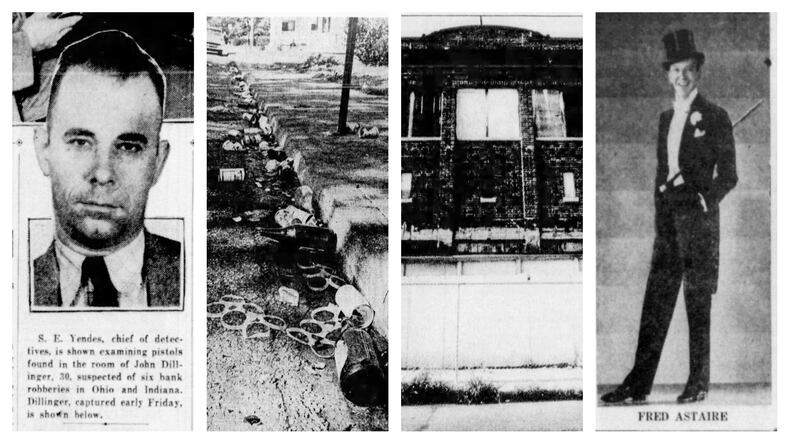Here’s a look at some stories happening the week of Sept. 17-23.
Sept. 22, 1933: John Dillinger arrested in Dayton
John Dillinger was arrested in Dayton in connection with six bank robberies in Ohio and Indiana.
Approximately $50,000 was said to be stolen during the robberies.
Dillinger was being guarded by officers armed with rifles and shotguns following his 1 a.m. arrest. The raid on the house where Dillinger was staying, on West First Street, was led by chief detective S.E. Yendes.
Four pistols, $2,600 in cash, quantities of rifle and shotgun shells, detailed notes explaining the quickest ways to escape from various cities and sacks full of carpet tacks were found in his room.
Dillinger was the leader of a group of bandits, and the police were worried his accomplices might try to free him.
Calm and smiling, Dillinger answered questions with a shrug and the comment, “See my lawyer.”
Sept. 19, 1942: Film stars visit Dayton for bond rally
Three popular film stars, Fred Astaire, Hugh Herbert and Ilona Massey, visited Dayton to help sell war bonds.
The stars first visited war workers at Aero-products division of General Motors.
A public rally was held in front of the courthouse in the afternoon, where the public was invited to meet the stars and buy war bonds. The stars would autograph all bond envelopes and would remain on the courthouse steps as long as bonds continued to be purchased. Sales reached $50,000 at the “bondwagon” event.
A gala dinner was held that evening at the Biltmore hotel, where the stars were the guests of honor. Admission to the dinner was the purchase of a $1,000 war bond.
Sept. 17, 1957: Police room rivals general store
In 1957, the police department “property room” was actually seven rooms.
The man who was in charge, officer R.N. Ratliff, compared it to a general store.
There were more than 2,000 individually-tagged items including confiscated weapons, evidence and recovered but unclaimed loot.
One room was for liquor, most of it destined to eventually be poured down the drain. Narcotics were kept in a locked vault.
In the gun room, weapons ranged from a pistol with over-and-under rifle and shotgun barrels to flintlock shotguns. Some 800 guns passed through the gun room each year, and one-third of them were eventually reclaimed by their owners.
The biggest problem was bicycles. The department took in about 150 bicycles a year that were never claimed. They went to twice-a-year auctions.
Other interesting items included a television set, a sewing machine, a car seat and clothes.
Sept. 20, 1970: UD students party as homeowners upset
Irate homeowners in the South Park area of Dayton threatened legal action against the University of Dayton and the city to bring a halt to weekend “block parties” in their neighborhood.
During four consecutive weekends, close to 1,000 students crowded the area near Keifaber and Alberta streets, drinking and setting fire to trash in the street.
The most recent weekend was called the rowdiest yet, leading to a man being shot in the leg during one of the block parties.
During those recent weeks, a small garage, furniture and an automobile all went up in flames.
Sometimes, students cleaned up the next morning.
Mayor James H. McGee didn’t think that was enough.
“They think they can satisfy this just by cleaning up,” he said. “the people out there are mad. They’re afraid to go outside their homes.”
Sept. 22, 1988: Roof leaks take toll on Classic Theater
Architects had been hired to study the possible restoration of the former Classic Theater at 815 W. Fifth St., which at one time had been the premier theater in Dayton for the Black community.
Water damage had destroyed much of the building but the façade was still in decent shape. There had been a hole in the roof for at least a decade.
The 1926 building originally had a ground-floor auditorium and a second-floor ballroom.
The theater closed in 1959 and had been owned by the city since 1978. The marquee and some of the original seats had been moved to storage at some point.
After several attempts to find funding for renovations, the theater was demolished in 1991.
Sept. 17, 1997: ‘Flyover’ sculpture lands magazine honor
Dayton’s Main Street memorial to the Wright brothers’ first flight had been called many names, and not all of them nice, including “Dinosaur tail” and “Rollercoaster.”
But national art magazine “Art in America” named the city’s “Flyover” sculpture by artist David Black as one of 30 notable examples of public art in 1996.
Each year the magazine solicited hundreds of nominations from local arts commissioners and the staff narrows down those submissions. Unsolicited nominations were also welcome.
Other pieces selected by the magazine were designed by Maya Lin, who is well-known for her design of Washington’s Vietnam Memorial and pop artist Roy Lichtenstein.
About the Author







